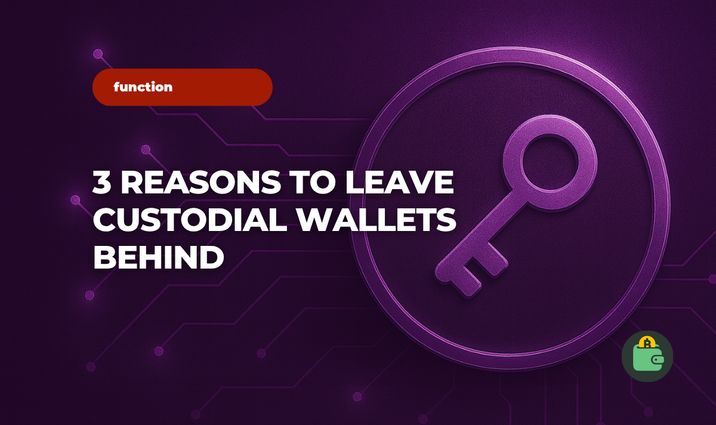Top 3 Reasons to Leave Custodial Wallets Behind

The more transparent crypto platforms become to governments, the more scam cases we see. This is a common opinion within the global crypto community, as many users believe that transparency doesn't necessarily mean safety. Maybe they’re right — but what we can say for sure is that there are cases where self-custodial wallets are more reliable than custodial ones. What are those cases? Let’s talk about them below.
The Short Explanation of Custodial and Non-Custodial Wallets
Custodial wallets store your private keys on their servers. You access your assets through an account (login, password, 2FA), but you don’t actually control the keys — the provider does. If you lose your seed phrase, you can recover access to your coins through support. Popular custodial wallets include Coinbase Wallet, Binance, Gemini, and others.
Non-custodial, or self-custodial, wallets don’t store your private keys — you do. That’s why self-custodial wallets are generally considered safer than custodial ones. You manage the keys and access to your assets entirely on your own. In other words, your security is your responsibility, so you must store the seed phrase — literally — under your pillow or in another very safe place. If you lose your seed phrase, you lose access to your crypto. Popular self-custodial wallets include Coin Wallet, MetaMask, Trust Wallet, and others.
3 Reasons Why You Should Switch from a Custodial Wallet to a Self-Custodial One
1. High Privacy
Most self-custodial wallets don’t require personal information or KYC verification. This can be a major advantage if you want to stay anonymous in the crypto space. However, converting fiat to crypto may still require KYC on exchanges.
2. Low Risk of Hacking and Loss
On custodial platforms, the concentration of funds under one provider makes them a target for hackers and increases the risk of frozen funds or loss in case the service goes bankrupt.
In self-custodial wallets, there is no single point of failure, making them less attractive to large-scale hackers. However, users can still fall victim to phishing or lose their keys — which can also result in loss of funds.
3. Advance level of crypto usage
Using self-custodial wallets often requires some technical knowledge: you need to understand the basics of blockchains, fees, and secure seed phrase storage. It’s a step toward becoming an advanced crypto user.
If you don’t control your keys, you don’t fully control your cryptocurrency — a concept summed up in the popular phrase, “Not your keys, not your coins.” Switching to a non-custodial wallet means taking full responsibility for the safety of your assets. The steps of this transition and its key considerations are detailed below.
How to Switch from a Custodial Wallet to a Self-Custodial One
Step 1. Create a non-custodial wallet
Choose an app or device for your new wallet and set it up. For example, you can set up a Coin Wallet mobile wallet.
Step 2: Get a deposit address
In your wallet interface, find the Receive or Deposit function. Select the cryptocurrency you want to transfer. The wallet will display your unique address for that coin.
Step 3. Begin withdrawal on the custodial wallet
Log in to your account on the exchange (or other custodial service) and select Withdraw or Send. Choose the cryptocurrency you want to withdraw, and paste the copied address from your non-custodial wallet into the recipient address field.
Pay close attention to the network selection: exchanges or multichain wallets often support multiple networks for the same coin. For example, USDT can be withdrawn as ERC-20 (Ethereum), BEP-20 (BNB Chain), or TRC-20 (Tron). Select the exact network that your self-custodial wallet supports.
⚠️ Never choose a random network “for lower fees” if your wallet doesn't support it — you risk losing your funds.
Step 4. Wait for the transaction to be confirmed
Confirmation time depends on the blockchain. Bitcoin can take 10–60 minutes (and usually needs 3–6 confirmations), Ethereum a few minutes (under normal load), and networks like Tron or BSC are faster (seconds or minutes). Be patient and don’t panic too early.
Step 5. Verify that the funds have arrived on your non-custodial wallet
Once the transaction receives the required number of confirmations, the funds should appear in your wallet. If your assets don’t show up, you may need to check token visibility settings or the derivation path for that coin.